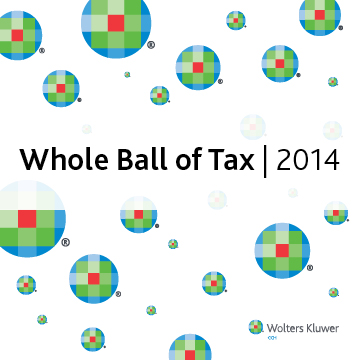| Home | About Us | Order Products | Press Center | Customer Service | Career Opportunities |

Wolters Kluwer, CCH can assist you with stories, including interviews with subject experts. Wolters Kluwer, CCH provides special CCH Tax Briefings on key topics at: CCHGroup.com/Legislation.
|
New Tax Rules for Charitable Contributions: Wolters Kluwer, CCH Analyzes the Tax Impact(RIVERWOODS, ILL., January 2014) – Because of new tax laws enacted as part of the American Taxpayer Relief Act (ATRA) which was signed into law last year, many retirees found themselves trying to beat the clock in order to take advantage of a provision which allowed them to make significant, tax-free charitable distributions from individual retirement accounts (IRA). For retirees and all taxpayers, CCH, a part of Wolters Kluwer and a leading global provider of tax, accounting and audit information, software and services (CCHGroup.com), takes a look at new and current rules for taking tax deductions for charitable donations. Deadline Passes for Direct IRA DonationsUp until December 31 of 2013, individuals age 70½ (the age at which required minimum distributions must be taken) or older were able to give tax-free, direct distributions of up to $100,000 per year from their IRAs to qualifying charities. The provision benefitted seniors who no longer had significant expenses, such as paying down home mortgages, to donate funds from their retirement accounts as tax-deductible charitable donations – without having to report the donated amount as retirement income or claim itemized deductions instead of the standard deduction. That was one of 55 tax breaks which expired at the end of the year. “It was a popular win-win provision for retirees who didn’t need all the money they had saved in retirement and for charitable organizations getting their donations,” said Wolters Kluwer, CCH Principal Federal Tax Analyst, Mark Luscombe, JD, LLM, CPA. “Donations below the $100,000 limit weren’t taxed and didn’t increase adjusted gross incomes, which could lead to more tax breaks.” ATRA also puts further restrictions on the value of tax deductions – including those for charitable donations – coming from individuals with incomes of $250,000 or more and for married couples filing jointly with incomes above $300,000. How Pease Limitations WorkThe deduction is reduced by 3 percent of the amount by which the taxpayer’s adjusted gross income (AGI) exceeds the income threshold. The income threshold at which Pease kicks in for 2013 is $250,000 for individuals and $300,000 for married couples filing jointly (adjusted for inflation in subsequent years). However, the amount of itemized deductions under Pease cannot be reduced by more than 80 percent. Also, certain items, such as medical expenses, investment interest and casualty or theft losses are excluded from the Pease limitation. Trying to understand Pease can quickly become confusing. Following are a few examples of how it can apply:
“Since about a third of taxpayers claim itemized deductions, individuals subject to the Pease limitation may be surprised to realize their deductions, including those to charity, have a lower value than they thought,” Luscombe said. Pease: A Potential Resurgence of Donor Advised and Charitable TrustsWhile some may be surprised by Pease, taxpayers anticipating its return may have taken actions in 2012 to ensure they could both continue to maximize their deductions while also maximizing their charitable contributions. For example, donor-advised funds allow you to place your money in a charitable fund and take the contribution at that time. You can then advise the fund to make distributions to charities of your choosing over as many years as you choose. Checklist for Claiming Charitable ContributionsWhether taxpayers are affected by new ATRA rules or not, everyone filing returns should know the basic rules checklist for claiming charitable contributions as tax deductions: ___ Deductions must be included as itemized deductions – This is done on Form 1040, Schedule A. ___ Donations must be for qualified charitable organizations – In order to receive a deduction, your contribution must be to a qualified charitable organization, typically given Code Sec. 170(c) status by the IRS and listed on their website. Deductions are not allowed for contributions to individuals, political organizations or unions for example. ___ Proper acknowledgement, proof of donation – For any cash or property valued at $250 or more, you must have a receipt (bank record, payroll deduction or written acknowledgment) identifying the organization, the value and a description of the property. If your overall noncash contributions exceed $500, you must file IRS Form 8283, Noncash Charitable Contributions, with your return; for items valued at more than $5,000, you must also generally include an appraisal by a qualified appraiser. ___ Text message donations records – If you made a quick, text message, charitable donation from your cell phone during the year, mobile phone bill records generally meet the record-keeping requirement. The billing item should include the name of the charity, date of donation and amount. ___ Know the special rules for certain noncash donated property. For example, clothes and household goods must generally be in good used or better condition to be tax deductible. ___ Subtract any benefit you received for the value of your donation. For example, if you bid on football game tickets at a charity’s silent auction that had a listed value of $400, but you secured them with a high bid of $600, you may only deduct the amount that exceeds the fair market value – or $200. About CCH, a part of Wolters KluwerCCH, a part of Wolters Kluwer (CCHGroup.com) is a leading global provider of tax, accounting and audit information, software and services. It has served tax, accounting and business professionals since 1913. Follow us on Twitter @CCHMediaHelp. Wolters Kluwer (www.wolterskluwer.com) is a market-leading global information services company. Wolters Kluwer is headquartered in Alphen aan den Rijn, the Netherlands. --###-- nb-14-18
|
© 2024, CCH INCORPORATED. All rights reserved. |
Back to Top | Print this Page | ||||||||||||||||||